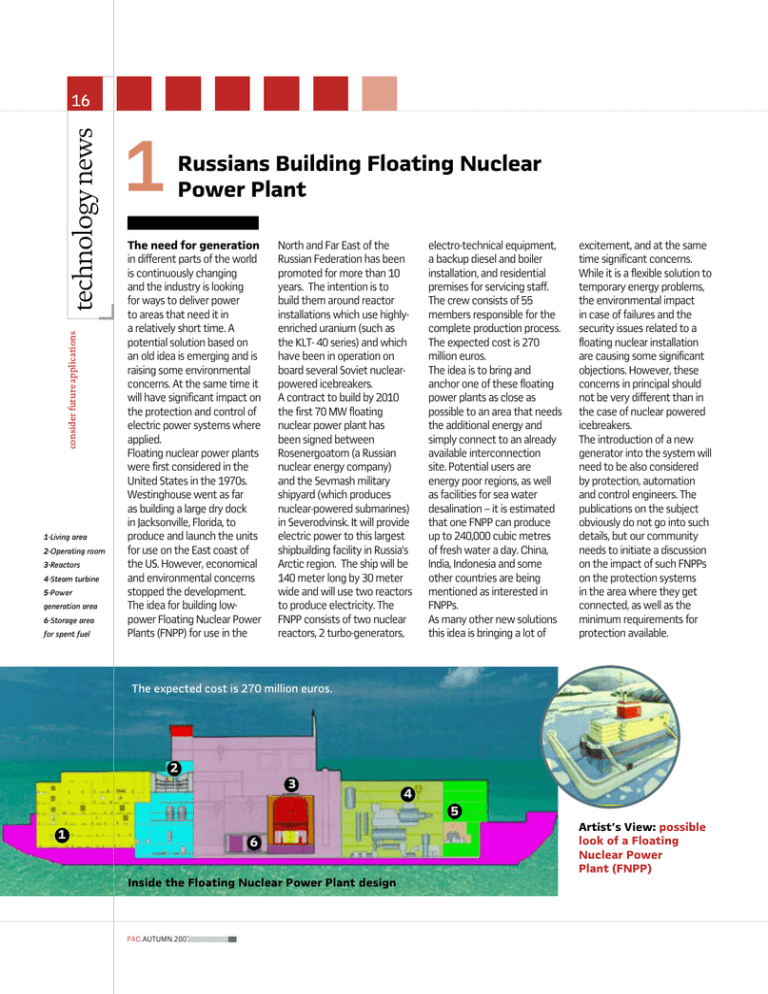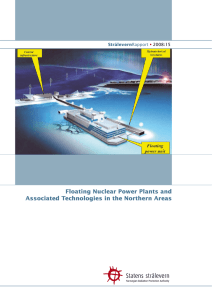1 s ew n
advertisement

consider future applications technology news 16 1-Living area 2-Operating room 3-Reactors 4-Steam turbine 5-Power generation area 6-Storage area for spent fuel 1 Russians Building Floating Nuclear Power Plant The need for generation in different parts of the world is continuously changing and the industry is looking for ways to deliver power to areas that need it in a relatively short time. A potential solution based on an old idea is emerging and is raising some environmental concerns. At the same time it will have significant impact on the protection and control of electric power systems where applied. Floating nuclear power plants were first considered in the United States in the 1970s. Westinghouse went as far as building a large dry dock in Jacksonville, Florida, to produce and launch the units for use on the East coast of the US. However, economical and environmental concerns stopped the development. The idea for building lowpower Floating Nuclear Power Plants (FNPP) for use in the North and Far East of the Russian Federation has been promoted for more than 10 years. The intention is to build them around reactor installations which use highlyenriched uranium (such as the KLT- 40 series) and which have been in operation on board several Soviet nuclearpowered icebreakers. A contract to build by 2010 the first 70 MW floating nuclear power plant has been signed between Rosenergoatom (a Russian nuclear energy company) and the Sevmash military shipyard (which produces nuclear-powered submarines) in Severodvinsk. It will provide electric power to this largest shipbuilding facility in Russia’s Arctic region. The ship will be 140 meter long by 30 meter wide and will use two reactors to produce electricity. The FNPP consists of two nuclear reactors, 2 turbo-generators, electro-technical equipment, a backup diesel and boiler installation, and residential premises for servicing staff. The crew consists of 55 members responsible for the complete production process. The expected cost is 270 million euros. The idea is to bring and anchor one of these floating power plants as close as possible to an area that needs the additional energy and simply connect to an already available interconnection site. Potential users are energy poor regions, as well as facilities for sea water desalination – it is estimated that one FNPP can produce up to 240,000 cubic metres of fresh water a day. China, India, Indonesia and some other countries are being mentioned as interested in FNPPs. As many other new solutions this idea is bringing a lot of excitement, and at the same time significant concerns. While it is a flexible solution to temporary energy problems, the environmental impact in case of failures and the security issues related to a floating nuclear installation are causing some significant objections. However, these concerns in principal should not be very different than in the case of nuclear powered icebreakers. The introduction of a new generator into the system will need to be also considered by protection, automation and control engineers. The publications on the subject obviously do not go into such details, but our community needs to initiate a discussion on the impact of such FNPPs on the protection systems in the area where they get connected, as well as the minimum requirements for protection available. The expected cost is 270 million euros. 2 3 4 5 1 6 Inside the Floating Nuclear Power Plant design PAC.AUTUMN.2007 Artist's View: possible look of a Floating Nuclear Power Plant (FNPP) 2 New Internet Speed Record The continuously increasing demand for improvement in the substation-substation and substation-system level communications is forcing protection and control engineers to look for new ways to meet these requirements. The new data transfer land speed records show that the time for revolutionary Internet based power system applications is not that far in the future. Using a modified version of TCP, a team consisting of members from the University of Tokyo, the WIDE Project, NTT Communications, and others accomplished both the Single Stream Class and the Multiple Stream Class records by transferring 585 gigabytes of data across 30,000 kilometers of network in about 30 minutes at an average rate of 9.08 gigabits per second. The speed achieved using the standard TCP a day before has been 7.67Gbps. The Internet2 Land Speed Record (I2LSR) competition for the highest-bandwidth, end-to-end networks is an open and ongoing contest. The rules require that a data transfer must run for a minimum of 10 continuous minutes over a minimum terrestrial distance of 100 kilometers with a minimum of two router hops in each direction between the source node and the destination node. All data must be transferred end-to-end between a single pair of IP addresses by bona fide TCP/IP protocol using hardware and software available commercially or as an open source to members of the Internet2 community. In computing the amount of data transferred, only data transferred from user-process-space buffer(s) in the datasource network application and in the data-sink network application may be counted. All data must be transferred in TCP packets encapsulated in IP packets that use no other IP addresses other than the designated source IP address and the designated destination IP address. More details and updates on the competition are available at http://www.internet2.edu/lsr/ Amsterdam The test network was spread over Asia and Europe WIDE IEEAF The speed achieved using CANARIE North America, technology news 17 SURFnet Seattle the standard TCP has been Tokio APAN/JGN2 Chicago 7.67 Gbps. NYC Using a modified version of TCP raised it to 9.08 Gbps. Data was transmitted across 30,000 km of network in about 30 min. Routing Point A L1 or L2 Switch Source and Destination PAC.AUTUMN.2007




